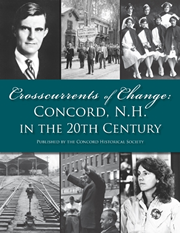Crosscurrents of Change: Concord, New Hampshire, in the Twentieth Century

Phillip Hamburger is all but forgotten now, but during much of the 20th century he was one of the great reporters and prose stylists. Hamburger came to Concord in 1959, and in a New Yorker article centered on the Eagle Hotel, he created a marvelous image. “There’s an old saying that if hotels could talk they would have plenty to say,” he wrote. “Plenty. Old hotels are like old actresses – filled with crinoline memories, gaslight romances, and cold lobster. If two old hotels got together, rocking on the porch, giggling and gossiping and rubbing citronella on their hands – well, history would learn a thing or two.”
The writers of Crosscurrents of Change: Concord, New Hampshire, in the Twentieth Century never got to the Eagle Hotel to gossip and giggle like an old actress, but what if Concord’s buildings could talk? How would they remember the 20th century?
Would the State House remember the politicians who strutted through the Memorial Arch and pointed with pride – or viewed with alarm – the policies of the state and nation? Theodore Roosevelt was undoubtedly the first president in the century to visit Concord. Toward the century’s end they all came, candidates running in New Hampshire’s presidential primary. There were of course visitors from other fields; the aviators ranged from Charles Lindbergh to Christa McAuliffe.
What if one of the benches along the base lines at White Park could talk, the ones used for Sunset League baseball? Do they remember the day Babe Ruth came to town? Of Red Rolfe, before he joined Ruth’s Yankees, scooping up a grounder at third base? Or do they prefer memories of the hundreds of young men who played without heraldry, doing their best to play a game they loved?
What sad tales could the New Hampshire State Hospital tell of the sons and daughters of the state who were dropped off at the entrance, never to emerge? What medical epics of life saving could come from Memorial, Pillsbury, and finally Concord Hospital?
Of course there’s the old red-brick Boston & Maine railroad station, the artery through which Concord’s economic and political lifeblood flowed. If it could talk, what would it say about the political manipulations, about the efforts of the railroad executives to make a buck by exchanging this municipal forum for a shopping center? Would the old depot reminisce about all Concord’s young men who went off to war, or would it prefer to rejoice when they came home to their families?
We can’t interview buildings, but the Concord Historical Society’s writers have interviewed their occupants and studied the documents those individuals left behind. In his New Yorker story about Concord, Hamburger discovered that Evalyn Walsh McLean, the wealthy wife of the owner of The Washington Post, stayed at the Eagle when she visited her son at St. Paul’s School. At the front desk McLean asked the clerk to keep a small package for her. The crudely wrapped item went into a safe with a broken lock. The next morning, McLean retrieved her package. It held the Hope Diamond.
“Nobody in the Eagle,” Hamburger wrote, “gave a damn one way or another, lock or no lock.”
We do care about Concord’s stories, because they give us a context, a greater explanation for our lives. And we’re still looking for those diamonds wrapped in crude packages.
– Editor John Milne
April 2010
